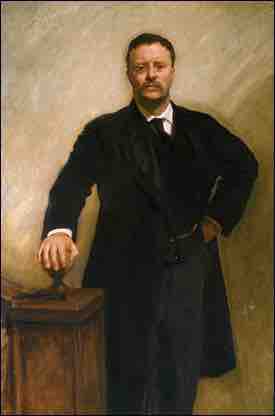Roosevelt's Presidency
Theodore Roosevelt Jr. was an American statesman, author, explorer, soldier, naturalist, and reformer who served as the 26th president of the United States from 1901 to 1909. As a leader of the Republican Party, he became a driving force during the Progressive Era in the early twentieth century.
Following the assassination of President McKinley in September 1901, Roosevelt, at age 42, succeeded to the office, becoming the youngest U.S. president in history. Leading his party and country into the Progressive Era, he championed his "Square Deal" domestic policies, promising the average citizen fairness, the breaking of trusts, regulation of railroads, and pure food and drugs. Making conservation a top priority, he established a myriad of new national parks, forests, and monuments intended to preserve the nation's natural resources. In foreign policy, he focused on Central America, where he began construction of the Panama Canal. He greatly expanded the U.S. Navy, and sent the Great White Fleet on a world tour to project the United States' naval power around the globe. His successful efforts to end the Russo-Japanese War won him the 1906 Nobel Peace Prize.
Elected in 1904 to a full term, Roosevelt continued to promote Progressive policies, but many of his efforts and much of his legislative agenda were eventually blocked in Congress. Roosevelt successfully groomed his close friend, William Howard Taft, to succeed him in the presidency. After leaving office, Roosevelt went on safari in Africa and toured Europe. Returning to the United States, he became frustrated with Taft's approach as his successor. He tried but failed to win the presidential nomination in 1912. Roosevelt founded his own Progressive party, the Bull Moose Party, and called for wide-ranging Progressive reforms. The split among Republicans enabled the Democrats to win both the White House and a majority in the Congress in 1912.
Roosevelt and Progressivism
Roosevelt pushed several pieces of domestic legislation through Congress that embodied the Progressive reform movement. Progressivism was a powerful political and social force by the turn of the century, and many Americans considered Roosevelt as the leader of the Progressive movement. To most contemporaries, Progressivism meant the use of science, engineering, technology, and the new social sciences to promote modernization and identify solutions to political corruption and inefficiency. Roosevelt, trained as a biologist, identified himself and his programs with this scientific approach to targeting and eliminating social and political ills.
Progressives such as Roosevelt also bitterly attacked what they perceived as elitist, powerful, and dangerous political machines and large corporations called "trusts," which were considered unfair and illegal business ventures designed to quash natural market competition and production. While president, Roosevelt targeted these trusts, particularly the railroad monopolies, by increasing the regulatory power of the federal government through the Elkins Act (1903) and the Hepburn Act (1906). The Hepburn Act of 1906 gave the Interstate Commerce Commission (ICC) the power to set maximum railroad rates and auditing power over the railroads' financial records, a task simplified by standardized booking systems. Through the Hepburn Act, the ICC's authority was extended to cover bridges, terminals, ferries, sleeping cars, express companies, and oil pipelines.
Under Roosevelt's leadership, the attorney general brought 44 suits against business monopolies (most notably against J.P. Morgan's Northern Securities Company and J.D. Rockefeller's Standard Oil Company). These suits were largely successful: Standard Oil was dispersed into 30 smaller companies that eventually competed with one another. Furthermore, to raise the visibility of labor and management issues, Roosevelt established a new federal Department of Commerce and Labor. Roosevelt's successful campaign against corporate monopolies earned him the nickname "Trust Buster."

Theodore Roosevelt
A portrait of Theodore Roosevelt painted by John Singer Sargent.